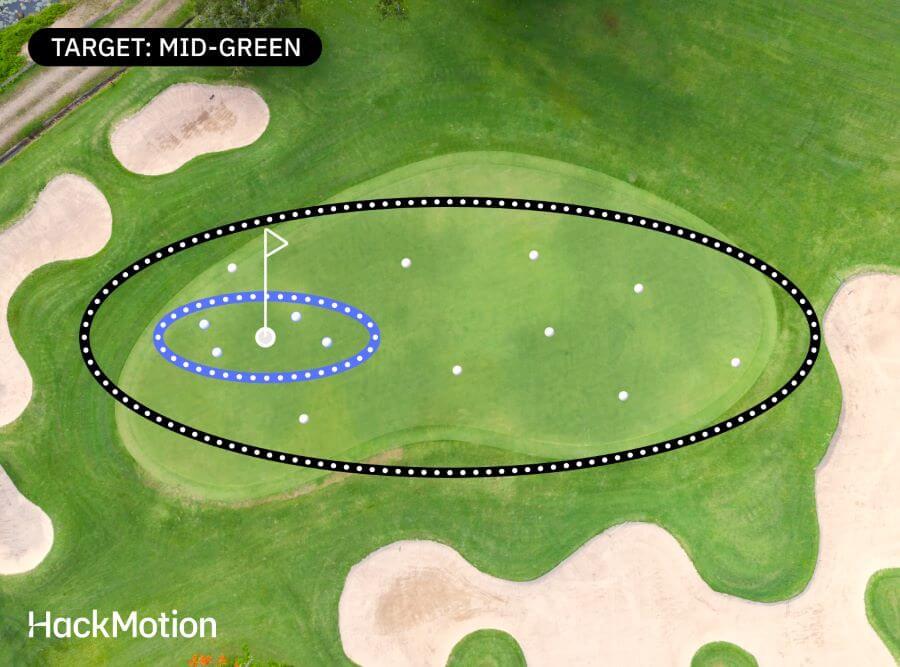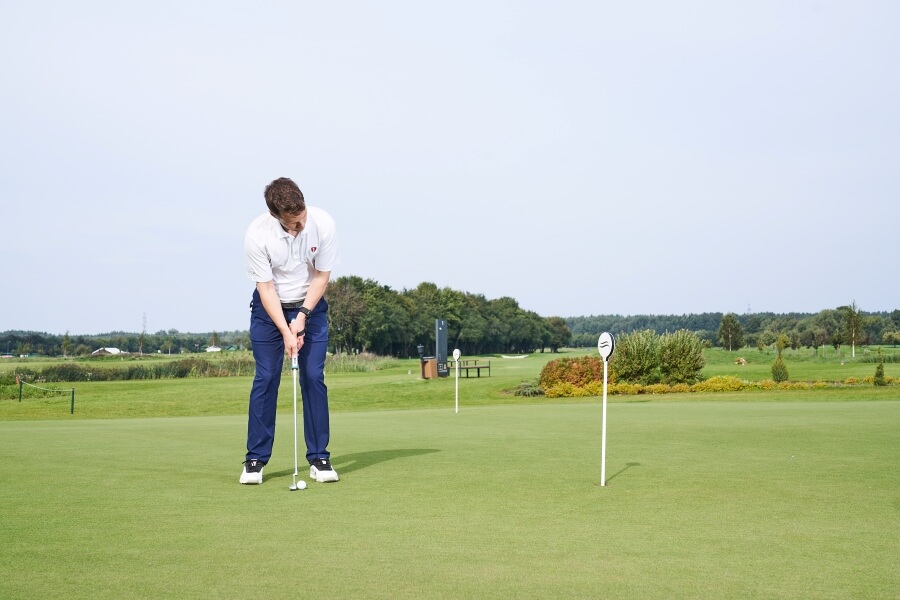10 Essential Golf Course Management Tips You Can’t Miss
At HackMotion, we spend a lot of time helping golfers improve their swing. But once your mechanics are dialed in and you’re hitting the ball the way you want, there’s another skill you’ll need to master, actually playing the game.
Smart course management is what separates savvy golfers from those who leave shots out there.
The good news? These course strategy tips work no matter your current handicap, and you can start using them the very next time you tee it up.
Golf Course Management Tips: Key Takeaways
Take a look at all of the golf course management tips in this article, but if you only have time for the key elements right now, here is what you need to know:
- To get good at golf course management and golf course strategy, you have to know how to analyze a golf course; you are no longer looking at just the hole. Take into account the hazards, the rough, the wind, the slopes, etc.
- Golf course management starts at the tee box, and it doesn’t end until the ball is in the hole.
- Controlling your ego and emotions is part of proper golf course management.
- Doing some preparation the day before a round of golf can make all the difference when it’s time to implement your golf course strategy.
- Knowing how to control the clubface of your golf club makes golf course management a lot easier.
To get personalized guidance on strategy and decision-making, check out golf coaches in your area who can help you manage the course more effectively.
Contents
What Exactly is Golf Course Management?
Golf course management is the way that you play your round of golf. As a golfer, you must manage what clubs you hit, what shots you plan to execute, and how you think the golf ball will respond to course conditions.
Good golf course management leads to lower scores; it’s as simple as that.
10 Golf Course Management Tips
Here are 10 golf course management tips that you can implement in your golf game today.
Take a close look at your current strategy on the golf course and identify areas where you may be falling short.
Choosing the Right Club from the Tee Box
You step onto the tee box with driver in hand, because that’s what you do on par 4s and 5s, right?
Not always.
The driver offers big reward, but also big risk. The closer you can get the ball to the hole the better but if that brings out of bounds and hazards into play it may not be better. It’s not that the driver should stay in the bag, it shouldn’t. But every tee shot is a decision, not an automatic green light for the driver.
Play some rounds where you vary what shot you hit on the tee box and see how it helps you.
Where to Miss
Knowing where to miss the golf ball is just as important as knowing where to aim. You probably think a lot about your target—but not enough about what happens if you don’t hit it perfectly.
As Ben Hogan said, “Golf is a game of misses.”
Think back to your last round. The big mistakes likely came from misses that left you in tough spots, buried in a bunker, long over the green, or blocked out by trees.
Here’s how to manage your misses smarter:
- Practice with tools like HackMotion to understand your common miss (hook, slice, push, etc.).
- Pick your ideal landing spot.
- Ask: If I miss my usual way, where does the ball end up?
- Adjust the target to give yourself room.
For example, if your miss is a big draw, don’t fire at a left pin with trouble nearby. Aim center or right. You’re still on the green, and still in the game. Most great players aim a lot of their shots to the center of the green.
Control the Ball
Not all golf shots should be on the same trajectory or the same flight. To be a great player, you must know how to control the flight of your golf ball.
Whether you are dealing with windy conditions or you simply need to punch the ball out from under a tree, controlling your shot trajectory is important.
The best way to learn to do this is to start with one golf club and have a high and a low shot you can hit with that club, then move on to the other clubs in your bag.
Typically speaking, you can follow these tips to hit a high and a low golf shot. The video below can help you with the draw and fade.
- To hit the ball higher, play it just a little further forward in the stance, try to have a slightly open clubface at impact, and keep the swing tempo smooth with a big high finish. The angle of attack can be a little steeper as well.
- To hit the ball lower, play it just slightly back in your stance, keep the swing compact, hold the finish a little lower, and have more shaft lean at impact.
Take Your Medicine
You may have heard the term take your medicine in golf. The point here is that when you make a mistake, you need to accept it and move on.
Let’s say you hit a slice with your driver off the tee box. The slice puts you in the woods behind a tree with a very small window of opportunity to make it to the green. Of course, this is frustrating, but you have to take your medicine.
Take the small punch out of the woods, put the ball back in play, and go from there. You still have a chance to hit a great approach shot and make a putt to save the hole.
The hero shot gets you into more trouble than it’s worth.
The Pin is Not Always Your Target
Do you aim at the pin on every approach shot?
It might feel like the right play, but often, it’s not.
Smart course management means looking at the whole green, not just the flag. The pin is your target, but getting too aggressive can turn a birdie chance into a bogey (or worse).
Instead, try to leave yourself a straight, uphill putt whenever possible. Pick a landing spot that gives you the best chance for that especially if the pin is tucked near trouble.
And don’t forget your typical miss. If going right at the pin brings bunkers or water into play, aiming for a safe 15-footer is more than acceptable.
You don’t always have to attack the pin to score well—sometimes, the smarter shot is the safer one.

Know Your Distances and Hit Them
There are two key pieces to the distance puzzle.
First, use a distance-measuring device that gives you a number you can trust. The days of pacing off yardages are over, know the exact distance to the hole, or at least the center of the green, on every shot.
Next, know your numbers. How far do you carry your 7-iron? What about your total distance? And don’t overlook your wedges, this is where scoring happens.
Wedge distance control is especially important because you’ll face these shots all round long. Approaches from 100 yards and in, chips, pitches, and recovery shots.
If you can’t control your yardages with wedges, you’ll constantly face long putts or tough up-and-downs.
But if you can control them, you’ll give yourself more makeable birdie and par chances than ever before. Practice distance control on the range by varying the club you use and the size of your golf swing.
Driving Range vs. Golf Course Mentality
The mentality on the golf course and the driving range are often different. On the range, you have no fear because the shots you take are not going to impact your score. On the golf course, you swing with more fear and control for fear of missing a shot and getting into trouble.
The next time you go to the driving range, start making shots count. Pick a target, hit one ball, and then pick another target. Play a golf course in your mind and challenge yourself to execute.
The next time you go to play a round of golf, trust that you have put the time in on the driving range and you know how to swing a club. If you don’t allow yourself to swing and actually go after the golf ball, you will never know your true potential on the course.
One thing that has helped me with this mentality is to practice with my HackMotion on the driving range. By using HackMotion, I’m able to see an overview of my practice session and my wrist angle position throughout.
I’ve played some of my best rounds where I gave up trying to force and control the ball and instead used the swing that I know I have.
Track Golf Stats
Every golfer has strengths and weaknesses and the only way to truly understand yours is to track your stats.
Whether you use strokes gained or just keep it old-school, tracking performance helps you practice with purpose and make smarter on-course decisions.
I once followed a Korn Ferry Tour player who went for every par 5 in two even hitting driver off the fairway to get there. Why? His up-and-down percentage was elite. He knew that even if he missed the green, his chances of making birdie were still high.
That’s the power of knowing your game. If your strength is wedge play from 100 yards, your best strategy might be to lay up. If you’re strong around the green, maybe going for it makes more sense.
Start tracking these key stats to make better decisions:
- Fairways hit
- Greens in regulation
- Up-and-down percentage
- Putts per round
- Approach proximity (especially from 100–150 yards)
- Miss tendency (short, long, left, or right)
The more you know about your game, the easier it is to play to your strengths—and lower your scores.
Have a Safe Swing and Safe Putting Stroke
You know those days when you are really struggling with something in your swing?
You may feel like nothing can go right, and it’s better for you to head out and leave the golf course for someone else.
If you can develop a safe swing, one that is maybe more compact and controlled, you can usually save a round. It probably won’t be the lowest round you ever shoot, but you should be able to get out of there with a decent score.
The same thing can apply to your putting stroke. If you can’t make anything, go back to the basic mechanics that you know to be right. Work with HackMotion putting into establishing a consistent wrist angle that you can continually repeat.
When your putting game goes south, think about that wrist angle, maintaining it, and hitting one great putt after another.
Adjust to the Course, Don’t Fight It
Course conditions need to be taken into account. After about a hole or two of play, you should have a good handle on what the wind is doing, how hard or soft the golf course is, and how the humidity or temperature is impacting ball flight.
The course conditions change from one round to the next, so you have to reset and analyze each round.
Certain golf course conditions will impact your entire game, but where you really see the difference is in the short game. If the greens are fast, you need to adjust where you land your chip and pitch shots and how hard you putt the ball.
Pay close attention to these conditions so that you can adjust your game accordingly.
Final Thoughts
Now that you have these 19 golf course management strategies and tips, you have nothing stopping you from reaching your goals on the course.
Take time to practice intentionally and take what you learn to the course. Use HackMotion to increase your confidence in your golf swing and your ability to work the ball. The extra confidence you have on the course will be well worth the time you put in.













